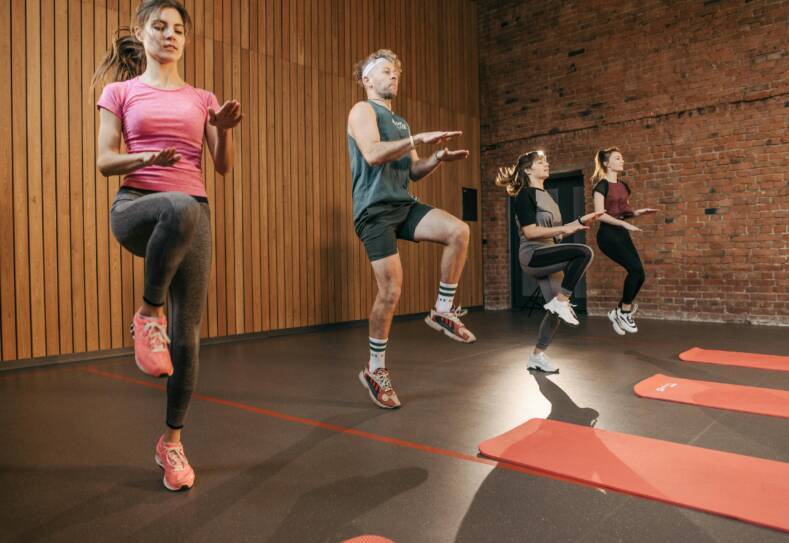Running in place is an exercise that involves jogging without forward motion, typically performed in confined spaces where traditional running isn’t feasible. It is considered an effective form of cardiovascular fitness that can be easily incorporated into daily routines. This static exercise activates the heart and lungs, contributing to overall aerobic endurance and health. Despite its simplicity, running in place can be an intense workout that burns calories and strengthens the lower body when performed at a high intensity.
Including running in place in one’s exercise regimen offers convenience and flexibility. For individuals who face barriers to outdoor running, such as inclement weather, safety concerns, or lack of nearby trails, this form of stationary jogging provides a viable alternative. It allows for cardiovascular fitness maintenance regardless of external circumstances. Moreover, this exercise can be adapted for varying fitness levels by adjusting speed and intensity, allowing everyone from beginners to advanced athletes to benefit.
While running in place does not offer the same muscle engagement and scenery change as outdoor jogging, it still delivers several health benefits. It is a practical tool for improving heart rate, managing weight, and increasing endurance. Additionally, it serves as a useful warm-up exercise, preparing the muscles for more strenuous activity without the need for specialized equipment or large spaces. As such, running in place is not just a stopgap for runners, but a legitimate workout in its own right for maintaining and improving fitness.
Physical and Cardiovascular Benefits
Running in place is a simple exercise that can offer significant physical and cardiovascular health benefits. It elevates heart rate and improves circulation, contributing positively to overall cardio health.
Heart Health and Circulation
Running in place stimulates the cardiovascular system, increasing heart rate and enhancing blood flow throughout the body. This activity helps to strengthen the heart muscle, akin to how resistance training strengthens skeletal muscle. Regular engagement in this exercise can lead to long-term cardiovascular benefits, such as improved blood pressure control and a reduction in the risk of heart disease.
- Increases Heart Rate: Regularly elevating the heart rate through running in place can improve cardiovascular endurance.
- Enhances Blood Flow: Improved circulation is a direct result of increased heart activity, contributing to better oxygen delivery to tissues.
Lung Capacity and Aerobic Efficiency
Another key advantage of running in place is the enhancement of lung capacity and aerobic efficiency. By demanding more from the respiratory system, it encourages the lungs to increase oxygen uptake, which can benefit one’s aerobic fitness levels. Over time, this increased demand leads to an adaptation whereby the lungs become more efficient at delivering oxygen to the bloodstream.
- Improves Lung Capacity: Running in place engages the respiratory muscles, potentially increasing lung volume over time.
- Boosts Aerobic Efficiency: Improved lung function translates to better aerobic capacity, allowing for more efficient utilization of oxygen during various activities.
By incorporating running in place into a regular fitness routine, individuals can reap these important physical and cardiovascular health benefits, contributing to overall health and well-being.
Muscular System Advantages
Running in place effectively targets various muscle groups, strengthening the core and upper body, as well as the lower body and leg muscles, which are fundamental for overall muscular endurance and strength.
Core and Upper Body Engagement
The act of running in place demands a sustained engagement of the core muscles to maintain balance and posture. It specifically works the abdominal muscles, which are crucial for stabilizing the torso during the motion. Core strength is vital for not only running but also for preventing back pain and improving overall stability. Additionally, arm movements involved in running in place can lead to increased arm muscle strength, aiding in the coordinated upper body workout.
- Muscles Engaged:
- Core: Abdominals and Obliques
- Upper Body: Deltoids, Biceps, and Triceps
Lower Body and Leg Strength
While running in place, one’s lower body bears the brunt of the workout, leading to stronger leg muscles. Engagement of the glutes, hamstrings, and the muscles around the knees occurs with every lift of the leg. This consistent lifting of one’s own body weight can aid in improving muscle strength and toning of the lower extremities. With regular practice, running in place can contribute to the development of leg muscles and potentially increase the calories burned through enhanced metabolic activity.
- Key Muscles Worked:
- Lower Body: Glutes, Quadriceps, Hamstrings
- Joints: Knees and Ankles
- Benefits:
- Enhanced muscle tone and strength
- Increased endurance and stamina
Running in place is a versatile exercise that offers considerable benefits for the muscular system, making it an accessible and efficient workout for those aiming to improve muscular health.
Weight Control and Calorie Burning
Running in place offers a convenient way to regulate weight and enhance calorie expenditure. It is an accessible exercise that boosts metabolic rate and contributes to effective weight management.
Metabolic Impact and Intensity
The metabolic impact of running in place is significant due to its ability to elevate heart rate and increase calorie burn. Intensity of the activity plays a crucial role; higher intensities result in a greater calorie burn. A moderate session can result in a calorie expenditure of approximately 300 calories for a person weighing 160 pounds in 30 minutes.
- Low Intensity: 280-300 calories/30 minutes for a 160-pound individual
- High Intensity: Increases calorie burn substantially
To reach weight loss goals, consistency and a deficit of 500 calories per day are often recommended, which equates to losing approximately one pound per week. Running in place is an effective way to contribute to this deficit as it burns calories in the body efficiently. However, the exact number of calories burned will vary based on one’s weight and the vigor of the exercise session.
Individuals weighing more can expect to burn more calories due to the higher energy cost of moving a larger body mass. For example, heavier individuals may burn between 472 and 690 calories per hour, depending on workout intensity. Regularity and maintaining a high intensity are key factors for optimizing calorie burning and achieving weight loss through running in place.
Form and Technique for Optimal Performance
Proper form and technique are vital in running in place, as they enhance performance and minimize the risk of injury. Attention to posture and correct movement execution form the foundation of a safe indoor jogging session.
Maintaining Proper Posture
Proper posture is the cornerstone of effective running in place. Individuals should:
- Head and Gaze: Keep the head up with the chin parallel to the ground and eyes looking forward.
- Shoulders: Hold shoulders relaxed and down, away from the ears.
- Core Engagement: Maintain a tight core throughout the exercise for stability.
- Arm Movement: Swing the arms naturally at around 90 degrees in coordination with leg movements.
Injury Prevention and Safety
Employing correct form is crucial for preventing injuries during indoor running:
- Foot Landing: It is recommended to land on the ball of the foot, avoiding heel contact with the ground.
- Foot Lift: Slightly raising the knees can help simulate the actual running movement and reduce strain.
- Breathing: Practice deep, rhythmic breathing to ensure oxygenation and prevent dizziness.
Adhering strictly to these form and technique guidelines will reduce the risk of injury and make running in place a beneficial workout component.
Workout Structure and Variability
Effective running in place workouts are not monotonous; they thrive on a structure that integrates variety through interval training and essential phases like warm-up and cool-down for comprehensive benefits.
Incorporating Interval Training
Interval training can enhance the effectiveness of running in place by alternating between high-intensity bursts and recovery periods. For example:
- High Intensity: 1 minute of high knees, pushing the tempo and engaging the core.
- Recovery: 2 minutes of a moderate pace jog to catch one’s breath and prepare for the next burst.
By cycling through these intervals, individuals can maintain a high heart rate and boost calorie burn as opposed to running at a constant pace.
Warm-Up and Cool-Down Importance
Every running in place session must begin with a warm-up and end with a cool-down to prep the muscles and promote recovery. Warm-up exercises may include:
- Leg swings and arm circles for 3 minutes.
- 5 minutes of walking in place or gentle dynamic stretches.
For cool-down:
- Incorporate 5 minutes of gradually slowing the pace of running in place.
- This should be followed by static stretches, focusing on the legs and lower back to reduce muscle stiffness.
Implementing these elements helps reduce the risk of injury and aids in the safe performance of the workout, despite the stationary terrain.
Psychological and Emotional Health
Running in place not only offers a convenient workout option but also carries significant psychological and emotional health benefits. This form of exercise is key for mood regulation and mental clarity.
Setting and Achieving Fitness Goals
When individuals set fitness goals and achieve them, even if the goal is as simple as running in place for a certain duration, they experience a sense of accomplishment. Achieving goals, regardless of their size, can lead to enhanced self-esteem and a boost in overall confidence. This practice of setting and reaching objectives can be particularly rewarding, as it demonstrates the individual’s commitment to their mental and emotional health.
- Self-Esteem: Accomplishing predetermined fitness targets can elevate one’s belief in personal abilities.
- Confidence: Each achieved goal builds confidence, leading to setting higher or more challenging goals.
Meeting these fitness milestones engenders a positive feedback loop, where success breeds further success. These victories, small or large, contribute to an improved state of mental well-being.
Comparing Running in Place to Other Exercises
When comparing running in place to exercises such as treadmill running and outdoor running, it is important for the reader to consider factors like space requirement, calorie burn, and specific muscle use.
Treadmill vs. Stationary Running
Running in place, or stationary jogging, requires no equipment and can be done in a small area. Calorie expenditure may vary between the two activities, with treadmill running often burning more calories due to potential for increased intensity and pace control. For example, a 150-pound individual may burn approximately 272 calories by jogging in place for 30 minutes as opposed to a higher calorie count of around 340 calories when using a treadmill at a 10-minute-per-mile pace.
Muscle Engagement: The treadmill provides a moving platform, which can offer better simulation of outdoor running mechanics. In contrast, stationary running focuses primarily on the leg muscles and, when performed with attention to form, can engage the abdominal muscles to improve posture.
Outdoor Running and Terrain Adaptations
Outdoor running presents opportunities to navigate various terrain, which can challenge the body’s stabilization muscles and enhance conditioning. Jogging in place does not offer this adaptability; however, it can be a useful substitute when outdoor conditions or accessibility to trails and paths are limited.
Terrain Variation vs. Consistency:
- Outdoor Terrain: Provides natural variations that can improve agility and strength.
- Stationary Running: Offers a consistent exercise environment, beneficial for those with space constraints or who require a controlled setting due to safety or health concerns.
Using stairs, whether in a home or outdoor setting, can increase the intensity of stationary running by introducing elevation and additional cardiovascular demand. This can help bridge the gap in exercise intensity between running in place and outdoor running on hilly or uneven surfaces.
Listening to Your Body and Adjusting Workouts
When engaging in any form of exercise, including running in place, the importance of listening to one’s body cannot be overstated. Recognizing and responding to the body’s signals can prevent injuries and promote more effective workouts.
Flexibility in Response: Maintaining flexibility in one’s workout regimen is crucial. If an individual experiences unexpected soreness or discomfort, they should consider modifying their workout intensity or duration. This might mean shortening the running in place session or integrating low-impact exercises that allow the muscles to recover while still staying active.
Understanding Body Mechanics: Paying attention to body mechanics during the exercise can help identify when something is not quite right. Individuals should be aware of how their muscles worked during the exercise. For example, if calf muscles start to consistently feel overworked, it may be a sign to adjust foot placement or overall form.
Signs of Discomfort: Discomfort can manifest in different ways, and individuals should be vigilant about any persistent or sharp pain. Here are a few indicators to watch for:
- Acute pain: Cease exercise and consult a professional if sharp pain occurs.
- Chronic soreness: Look at training volume and recovery strategies.
- Unusual fatigue: Reduce intensity or take an extra rest day.
Using these signals as a guide, individuals can make informed decisions about when to push forward and when to scale back, leading to safer, more effective workouts and better overall fitness outcomes.








